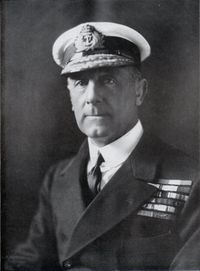Jellicoe:Director of Naval Ordnance: Difference between revisions
From The Dreadnought Project
Jump to navigationJump to search
Simon Harley (talk | contribs) (Oops.) |
Simon Harley (talk | contribs) No edit summary |
||
| Line 6: | Line 6: | ||
:On coming to London my wife and I took up our residence at 25 Dreycott Place, where our second daughter Betty was born in 1905. Our third daughter Myrtle being born at my father in law's house in Belgrave Square in 1908.<ref>British Library. Jellicoe Papers. Add. MSS. 49038. f. 53.</ref> | :On coming to London my wife and I took up our residence at 25 Dreycott Place, where our second daughter Betty was born in 1905. Our third daughter Myrtle being born at my father in law's house in Belgrave Square in 1908.<ref>British Library. Jellicoe Papers. Add. MSS. 49038. f. 53.</ref> | ||
As Director of Naval Ordnance, Jellicoe commented on the armament of new ships. For unarmoured cruisers of the 1908-1909 programme, he wrote in June, 1907, that they ought to be armed with 4-inch guns, reasoning that "One of the difficulties an Admiral often has to contend with is the not unnatural tendency of cruiser captains to fight instead of collecting and forwarding information … if the calibre of gun is kept down to 4 inch, the temptation to fight largely disappears."<ref>"Statement by Rear-Admiral Sir John Jellicoe when Director of Naval Ordnance on the Subject of the Armament of the Cruisers for the 1908-1909 Programme." Tweedmouth Papers. Royal Naval Museum, Portsmouth. MSS 252/9/1.</ref> | |||
==Footnotes== | ==Footnotes== | ||
Revision as of 16:35, 24 December 2010
| ||||||||
- On leaving the Drake on Nov 21st 1904 I went to the Admiralty to serve on the Committee associated with Sir John Fishers work there as 1st Sea Lord, an appointment which he had taken up on Oct 21st. The remaining members of the Board Lord Selborne (1st Lord) Admiral Sir Charles Drury (2nd Sea Lord) Admiral Sir William May (Controller) and Admiral F. S. Inglefield (4th Sea Lord). I was particularly detailed to consider the designs of the new Battleship which it was intended to arm entirely with 12 inch guns instead of the mixed armament which had been the rule hitherto.[1] Eventually the design of HMS Dreadnought was selected, but before this decision was reached I had taken up the appointment of Director of Naval Ordnance dated 24/2/1905/ I was still associated with the design of this new battleship while holding this appointment.
- In those days the staff of the D.N.O. composed an Assistant Director of Torpedoes, three officers of Commanders or Lieutenants rank for gunnery work, three for torpedo work and a marines' officer for general duties.
- On coming to London my wife and I took up our residence at 25 Dreycott Place, where our second daughter Betty was born in 1905. Our third daughter Myrtle being born at my father in law's house in Belgrave Square in 1908.[2]
As Director of Naval Ordnance, Jellicoe commented on the armament of new ships. For unarmoured cruisers of the 1908-1909 programme, he wrote in June, 1907, that they ought to be armed with 4-inch guns, reasoning that "One of the difficulties an Admiral often has to contend with is the not unnatural tendency of cruiser captains to fight instead of collecting and forwarding information … if the calibre of gun is kept down to 4 inch, the temptation to fight largely disappears."[3]
Footnotes
- ↑ Note by Jellicoe: There was one very great disadvantage in this mixed armament, connected with the control of fire and the substitution of one pattern of guns for the main armament had very great advantages in this respect. In spite of this, for some reason afterwards we built light cruisers with a mixed armament of 6" guns and 4" guns, a step against which I always protested.
- ↑ British Library. Jellicoe Papers. Add. MSS. 49038. f. 53.
- ↑ "Statement by Rear-Admiral Sir John Jellicoe when Director of Naval Ordnance on the Subject of the Armament of the Cruisers for the 1908-1909 Programme." Tweedmouth Papers. Royal Naval Museum, Portsmouth. MSS 252/9/1.
Bibliography
